A Quantitative Evaluation of Hyperpycnal Flow Occurrence in a Temperate Coastal Zone: The Example of the Salerno Gulf (Southern Italy)
Abstract
1. Introduction
- the definition of the “normal” sand/mud ratio at the seabed in function of depth, by assessing a regression curve valid for the studied area—in this case in the Salerno Gulf—and based on the measurements of the sand/mud content in the grabs and in the uppermost levels of box-core;
- the identification of the horizons in the sediment record whose sand/mud ratio is higher than expected by the regression curve.
2. Geological and Morphological Settings
3. Method
3.1. Watershed Morphology
3.2. Rivers Discharge and Sediment Load
3.3. Marine Sediment Analysis
4. Results
4.1. Hypsometric Analysis
4.2. Hyperpycnal Flows
4.3. Grain Size of Marine Sediment and Depth Correlation
5. Discussion
5.1. Analysis of SGCs Morphology and Its Role in Promoting HF Events
5.2. Age Constraint of the Event Beds.
5.3. The Anomalous S/M Layers Occurrence in the Marine Sink
6. Conclusions
Author Contributions
Funding
Acknowledgments
Conflicts of Interest
References
- Guzzetti, F.; Reichenbach, P.; Cardinali, M.; Galli, M.; Ardizzone, F. Probabilistic landslide hazard assessment at the basin scale. Geomorphology 2005, 72, 272–299. [Google Scholar] [CrossRef]
- Vennari, C.; Parise, M.; Santangelo, N.; Santo, A. A database on flash flood events in Campania, southern Italy, with an evaluation of their spatial and temporal distribution. Nat. Hazards Earth Syst. Sci. 2016, 16, 2485–2500. [Google Scholar] [CrossRef]
- Doswell, C.A. Hydrology, floods and drought/ Flooding. In Encyclopedia of Atmospheric Sciences, 2nd ed.; Elsevier: Amsterdam, The Netherlands, 2015; pp. 201–208. ISBN 978-0-12-382225-3. [Google Scholar]
- Borga, M.; Boscolo, P.; Zanon, F.; Sangati, M. Hydrometeorological analysis of the 29 August 2003 flash flood in the Eastern Italian Alps. J. Hydrometeorol. 2007, 8, 1049–1067. [Google Scholar] [CrossRef]
- Merheb, M.; Moussa, R.; Abdallah, C.; Colin, F.; Perrin, C.; Baghdadi, N. Hydrological response characteristics of Mediterranean catchments at different time scales: A meta-analysis. Hydrol. Sci. J. 2016, 61, 2520–2539. [Google Scholar] [CrossRef]
- Mulder, T.; Syvitski, J.P.M.; Migeon, S.; Faugeresa, J.C.; Savoyed, B. Marine hyperpycnal flows: Initiation, behavior and related deposits. A review. Mar. Pet. Geol. 2003, 20, 861–882. [Google Scholar] [CrossRef]
- Katz, T.; Ginat, H.; Eyal, G.; Steiner, Z.; Braun, Y.; Shalev, S.; Goodman-Tchernov, B.N. Desert flash floods form hyperpycnal flows in the coral-rich Gulf of Aqaba, Red Sea. Earth Planet. Sci. Lett. 2015, 417, 87–98. [Google Scholar] [CrossRef]
- Casalbore, D.; Chiocci, F.L.; Scarascia Mugnozza, G.; Tommasi, P.; Sposato, A. Flash-flood hyperpycnal flows generating shallow-water landslides at Fiumara mouths in Western Messina Strait (Italy). Mar. Geophys. Res. 2011, 32, 257–271. [Google Scholar] [CrossRef]
- Pierdomenico, M.; Casalbore, D.; Chiocci, F.L. Massive benthic litter funnelled to deep sea by flash-flood generated hyperpycnal flows. Sci. Rep. 2019, 9, 5330. [Google Scholar] [CrossRef]
- Esposito, E.; Porfido, S.; Violante, C.; Molisso, F.; Sacchi, M.; Santoro, G.; Spiga, E. Flood risk estimation through document sources analysis: The case of the Amalfi rocky coast. In Marine Research at CNR, Marine Geology; Brugnoli, E., Cavarretta, G., Mazzola, S., Trincardi, F., Ravaioli, M., Santoleri, R., Eds.; Marine Research at CNR: Rome, Italy, 2011; pp. 1–12. ISSN 2239-5172. [Google Scholar]
- Santo, A.; Di Crescenzo, G.; Del Prete, S.; Di Iorio, L. The Ischia Island flash flood of November 2009 (Italy): Phenomenon analysis and flood hazard. Phys. Chem. Earth 2012, 49, 3–17. [Google Scholar] [CrossRef]
- Alessio, G.; De Falco, M.; Di Crescenzo, G.; Nappi, R.; Santo, A. Flood hazard of the Somma-Vesuvius region based on historical (19–20th century) and geomorphological data. Ann. Geophys. 2013, 56, S0434. [Google Scholar] [CrossRef]
- Chirico, G.B.; Di Crescenzo, G.; Santangelo, N.; Santo, A.; Scorpio, V. Alluvial fan flooding hazard: The study case of Teglia (San Gregorio Magno, Salerno). Rend. Online Soc. Geol. It. 2012, 2, 456–458. [Google Scholar]
- Santo, A.; Santangelo, N.; Di Crescenzo, G.; Scorpio, V.; De Falco, M.; Chirico, G.B. Flash flood occurrence and magnitude assessment in an alluvial fan context: The October 2011 event in the Southern Apennines. Nat. Hazards 2015, 78, 417–442. [Google Scholar] [CrossRef]
- Santangelo, N.; Santo, A.; Di Crescenzo, G.; Foscari, G.; Liuzza, V.; Sciarrotta, S.; Scorpio, V. Flood susceptibility assessment in a highly urbanized alluvial fan: The case study of Sala Consilina (southern Italy). Nat. Hazards Earth Syst. Sci. 2011, 11, 2765–2780. [Google Scholar] [CrossRef]
- Santangelo, N.; Daunis-i-Estadella, J.; Di Crescenzo, G.; Di Donato, V.; Faillace, P.; Martin-Fernandez, J.A.; Romano, P.; Santo, A.; Scorpio, V. Topographic predictors of susceptibility to alluvial fan flooding, Southern Apennines. Earth Surf. Proc. Land. 2012, 37, 803–817. [Google Scholar] [CrossRef]
- Violante, C.; Braca, G.; Esposito, E.; Tranfaglia, G. The 9 September 2010 torrential rain and flash flood in the Dragone catchment, Atrani, Amalfi Coast (southern Italy). Nat. Hazards Earth Syst. Sci. 2016, 16, 333–348. [Google Scholar] [CrossRef]
- Mulder, T.; Syvitski, J.P.M. Turbidity currents generated at river mouths during exceptional discharges to the world oceans. J. Geol. 1995, 103, 285–299. [Google Scholar] [CrossRef]
- Porfido, S.; Esposito, E.; Mazzola, S.; Violante, C.; Santoro, G.; Spiga, E. Frane ed alluvioni nel salernitano e a Cava de’ Tirreni 9-31. In Lo Alluvione, il Disastro del 1773 a Cava tra Memoria Storica e Rimozione; Foscari, G., Esposito, E., Mazzola, S., Porfido, S., Sciarotta, S., Santoro, G., Eds.; Edisud: Bari, Italy, 2013; pp. 9–31. ISBN 978-88-95154-87-9. [Google Scholar]
- Porfido, S.; Esposito, E.; Molisso, F.; Sacchi, M.; Violante, C. Flood historical data for flood risk estimation in coastal areas, eastern Tyrrhenian Sea, Italy. Landslide Sci. Pract. Complex Environ. 2013, 5, 103–108. [Google Scholar]
- Budillon, F.; Violante, C.; Conforti, A.; Esposito, E.; Insinga, D.; Iorio, M.; Porfido, S. Event beds in the recent prodelta stratigraphic record of the small flood-prone Bonea Stream (Amalfi Coast, Southern Italy). Mar. Geol. 2005, 222–223, 419–441. [Google Scholar] [CrossRef]
- Porfido, S.; Esposito, E.; Alaia, F.; Molisso, F.; Sacchi, M. The Use of Documentary Sources for Reconstructing Flood Chronologies on the Amalfi Rocky Coast (Southern Italy). Geohazard in Rocky Coastal Areas; Special Publications; The Geological Society: London, UK, 2009; Volume 322, pp. 173–187. [Google Scholar] [CrossRef]
- Milliman, J.D.; Syvitski, J.P.M. Geomorphic/tectonic control of sediment discharge to the ocean: The importance of small mountainous rivers. J. Geol. 1992, 100, 525–544. [Google Scholar] [CrossRef]
- Wilford, D.J.; Sakals, M.E.; Innes, J.L.; Sidle, R.C.; Bergerud, W.A. Recognition of debris flow, debris flood and flood hazard through watershed morphometrics. Landslides 2004, 1, 61–66. [Google Scholar] [CrossRef]
- Zavala, C.; Pan, S.X. Hyperpycnal flows and hyperpycnites; Origin and distinctive characteristics. Lithol. Reserv. 2018, 30, 1–27. [Google Scholar]
- Warrick, J.A.; Barnard, P.L. The offshore export of sand during exceptional discharge from California rivers. Geology 2012, 40, 787–790. [Google Scholar] [CrossRef]
- Mathalon, A.; Goodman-Tchernov, B.; Hill, P.; Kálmán, Á.; Katz, T. Factors influencing flashflood deposit preservation in shallow marine sediments of a hyperarid environment. Mar. Geol. 2019, 411, 22–35. [Google Scholar] [CrossRef]
- Kniskern, T.A.; Mitra, S.; Orpin, A.R.; Harris, C.K. Characterization of a flood-associated depositon the Waipaoa River shelf using radioisotopes and terrigenous organic matter abundance and composition. Cont. Shelf Res. 2014, 86, 66–84. [Google Scholar] [CrossRef]
- Shanmugham, G. The hyperpycnite problem. J. Palaeogeogr. 2018. [Google Scholar] [CrossRef]
- Carter, L.; Milliman, J.D.; Talling, P.J.; Gavey, R.; Wynn, R.B. Near-synchronous and delayed initiation of long run-out submarine sediment flows from a record-breaking river flood, offshore Taiwan. Geophys. Res. Lett. 2012, 39, L12603. [Google Scholar] [CrossRef]
- Warrick, J.A.; Simms, A.R.; Ritchie, A.; Steel, E.; Dartnell, P.; Conrad, J.E.; Finlayson, D.P. Hyperpycnal plume-derived fans in the Santa Barbara Channel, California. Geophys. Res. Lett. 2013, 40, 2081–2086. [Google Scholar] [CrossRef]
- Mulder, T.; Alexander, J. The physical character of subaqueous sedimentary density flows and their deposits. Sedimentology 2001, 48, 269–299. [Google Scholar] [CrossRef]
- Mulder, T.; Migeon, S.; Savoye, B.; Faugères, J.-C. Inversely graded turbidite sequences in the deep Mediterranean; a record of deposits from flood-generated turbidity currents? Geo Mar. Lett. 2001, 21, 86–93. [Google Scholar]
- Alberico, I.; Amato, V.; Aucelli, P.P.C.; Di Paola, G.; Pappone, G.; Rosskopf, C.M. Historical and recent changes of the Sele River coastal plain (Southern Italy): Natural variation and human pressures. Rend. Fis. Acc. Lincei 2012, 23, 3–12. [Google Scholar] [CrossRef]
- Cinque, A.; Romano, P.; Budillon, F.; D’Argenio, B.; Bellonia, A.; Caiazzo, C.; Fabbrocino, S.; Ferraro, L.; Insinga, D.D.; Rosskopf, C. Note Illustrative Della Carta Geologica d’Italia Alla Scala 1:50.000, Foglio 486, Foce del Sele; Regione Campania per Ispra, Servizio Geologico d’Italia, SystemCart srl.: Rome, Italy, 2009; pp. 1–144. ISBN 9788824029209.
- Lambeck, K.; Anzidei, M.; Antonioli, F.; Benini, A.; Esposito, A. Sea level in Roman time in the Central Mediterranean and implications for recent change. Earth Planet. Sci. Lett. 2004, 224, 563–575. [Google Scholar] [CrossRef]
- Nyberg, B.; Helland-Hansen, W.; Gawthorpe, R.L.; Sandbakken, P.; Eide, C.H.; Sømme, T.; Hadler-Jacobsen, F.; Leiknes, S. Revisiting morphological relationships of modern source-to-sink segments as a first-order approach to scale ancient sedimentary systems. Sediment. Geol. 2018, 373, 111–133. [Google Scholar] [CrossRef]
- Sømme, T.O.; Helland-Hansen, W.; Martinsen, O.J.; Thurmond, J.B. Relationships between morphological and sedimentological parameters in source-to-sink systems: A basis for predicting semi-quantitative characteristics in subsurface systems. Basin Res. 2009, 21, 361–387. [Google Scholar] [CrossRef]
- Casciello, E.; Cesarano, M.; Pappone, G. Extensional detachment faulting on the Tyrrhenian margin of the southern Apennines contractional belt (Italy). J. Geol. Soc. 2006, 163, 617–629. [Google Scholar] [CrossRef]
- Kastens, K.A.; Mascle, J. The geological evolution of the Tyrrhenian Sea: An introduction to the scientifcic results of ODP Leg 107. In Proceedings of Ocean Drilling Programme, Scientific Results; Ocean Drilling Program: College Station, TX, USA, 1990; Volume 107, pp. 3–26. [Google Scholar]
- Patacca, E.; Sartori, R.; Scandone, P. Tyrrhenian basin and Apenninic arcs: Kinematic relations since late Tortonian times. Mem. Soc. Geol. It. 1990, 45, 425–451. [Google Scholar]
- Doglioni, C. A proposal for the kinematic modelling of W-dipping subductions-possible applications to the Tyrrhenian-Apennines system. Terra Nova 1991, 3, 423–434. [Google Scholar] [CrossRef]
- Faccenna, C.; Funiciello, F.; Giardini, D.; Lucente, P. Episodic back-arc extension during restricted mantle convection in the Central Mediterranean. Earth Planet. Sci. Lett. 2001, 187, 105–116. [Google Scholar] [CrossRef]
- Casciello, E.; Cesarano, M.; Conforti, A.; D’Argenio, B.; Marsella, E.; Pappone, G.; Sacchi, M. Extensional detachment geometries on the Tyrrhenian margin (the Salerno district). In Mapping Geology in Italy; Pasquarè, G., Venturini, C., Groppelli, G., Eds.; APAT: Firenze, Italy, 2004; pp. 29–34. ISBN 88-448-0189-2. [Google Scholar]
- Patacca, E. Stratigraphic constraints on the CROP-04 sismic line interpretation: San Fele 1, Monte Foi 1 and San Gregorio Magno 1 wells (Southern Apennines, Italy). Boll. Soc. Geol. It. 2007, 7, 185–239. [Google Scholar]
- Cinque, A.; Guida, F.; Russo, F.; Santangelo, N. Dati cronologici e stratigrafici su alcuni depositi continentali della Piana del Sele (Campania): I “Conglomerati di Eboli”. Geogr. Fis. Dinam. Quatern. 1988, 11, 39–44. [Google Scholar]
- Brancaccio, L.; Cinque, A.; Russo, F.; Santangelo, N.; Alessio, M.; Allegri, L.; Improta, S.; Belluomini, G.; Branca, M.; Delitala, L. Nuovi dati cronologici sui depositi marini e continentali della Piana del F. Sele e della costa settentrionale del Cilento (Campania, Appennino Meridionale). In Proceedings of the 74th Congresso Nazionale della Società Geologica Italiana, Sorrento, Italy, 13–17 September 1988; pp. 55–62. [Google Scholar]
- Amato, A.; Ascione, A.; Cinque, A.; Lama, A. Morfoevoluzione, sedimentazione e tettonica recente dell’alta Piana del Sele e delle sue valli tributarie (Campania). Geogr. Fis. Dinam. Quatern. 1991, 14, 5–16. [Google Scholar]
- Cinque, A.; Romano, P. Segnalazione di nuove evidenze di antiche linee di riva in Penisola Sorrentina (Campania). Geogr. Fis. Dinam. Quatern. 1990, 13, 23–36. [Google Scholar]
- Amato, V.; Aucelli, P.P.C.; Ciampo, G.; Cinque, A.; Di Donato, V.; Pappone, G.; Petrosino, P.; Romano, P.; Rosskopf, C.M.; Russo Ermolli, E. Relative sea level changes and paleogeographical evolution of the southern Sele plain (Italy) during the Holocene. Quater. Intern. 2013, 288, 112–128. [Google Scholar] [CrossRef]
- Budillon, F.; Senatore, M.R.; Insinga, D.D.; Iorio, M.; Lubritto, C.; Roca, M.; Rumolo, P. Late Holocene sedimentary changes in shallow water settings: The case of the Sele river offshore in the Salerno Gulf (south-eastern Tyrrhenian Sea, Italy). Rend. Fis. Acc. Lincei 2012, 23, 25–43. [Google Scholar] [CrossRef]
- Barra, D.; Calderoni, G.; Cinque, A.; De Vita, P.; Rosskopf, C.; Russo Ermolli, E. New data on the evolution of the Sele River coastal plain (Southern Italy) during the Holocene. Alp. Mediterr. Quat. 1998, 11, 287–299. [Google Scholar]
- Pappone, G.; Casciello, E.; Cesarano, M.; D’Argenio, B.; Conforti, A. Note Illustrative Della Carta Geologica d’Italia alla Scala 1:50.000, Foglio 467, Salerno; Ispra, Servizio Geologico d’Italia, SystemCart srl.: Rome, Italy, 2009; pp. 1–122. ISBN 8824029191.
- Strahler, A.N. Hypsometric (area-altitude) analysis of erosional topography. Geol. Soc. Am. Bull. 1952, 63, 1117–1141. [Google Scholar] [CrossRef]
- Liffner, J.W.; Hewa, G.A.; Peel, C.M. The sensitivity of catchment hypsometric and hypsometric properties to DEM resolution and polynomial order. Geomorphology 2018, 309, 112–120. [Google Scholar] [CrossRef]
- Harlin, J.M. Statistical moments of hypsometric curve and its density function. J. Int. Assoc. Math. Geol. 1978, 10, 59–72. [Google Scholar] [CrossRef]
- Luo, W. Quantifying groundwater sapping process with a hypsometric analysis technique. J. Geophys. Res. 2000, 105, 1685–1694. [Google Scholar] [CrossRef]
- Pérez-Pena, J.V.; Azanon, J.M.; Azor, A. CalHypso: An ArcGis extension to calculate hypsometric curves and their statistical moments. Applications to drainage basin analysis in SE Spain. Comput. Geosci. 2008, 35, 1214–1223. [Google Scholar] [CrossRef]
- Water Management Plan of Southern Apennines Hydrographic District (2015–2021). Study of Hydrological Balance and Minimal River Runoff. Available online: http://www.Ildistrettoidrograficodellappenninomeridionale.it/3%20%20bilancio%20idrologico%20idrico%20e%20mdv.pdf (accessed on 25 November 2019).
- Syvitski, J.P.M.; Milliman, J.D. Geology, geography, and humans battle for dominance over the delivery of fluvial sediment to the coastal ocean. Chic. J. 2007, 115, 1–19. [Google Scholar] [CrossRef]
- Rossi, F.; Villani, P. Valutazione Delle Piene in Campania; GNDCI-CNR, Gruppo Nazionale per la difesa dalle catastrofi idrogeologiche, Linea 1; Editore Presidenza del Consiglio dei Ministri, Dipartimento della Protezione Civile: Roma, Italy, 1994.
- Budillon, F.; Aiello, G.; Conforti, A.; D’Argenio, B.; Ferraro, L.; Marsella, E.; Monti, L.; Pelosi, N.; Tonielli, R. The Coastal Depositional Systems along the Campania Continental Margin (Italy, Southern Tyrrhenian Sea) since the Late Pleistocene: New Information Gathered in the Frame of the CARG Project. In Marine Research at CNR, Chapter Marine Geology; Brugnoli, E., Cavarretta, G., Mazzola, S., Trincardi, F., Ravaioli, M., Santoleri, R., Eds.; National Research Council of Italy: Rome, Italy, 2011; pp. 540–551. ISSN 2239-5172. [Google Scholar]
- Budillon, F.; Esposito, E.; Iorio, M.; Pelosi, N.; Porfido, S.; Violante, C. The geological record of storm events over the last 1000 years in the Salerno Bay (Southern Tyrrhenian Sea): New proxy evidences. Adv. Geosci. 2005, 2, 123–130. [Google Scholar] [CrossRef]
- Ohmori, H. Changes in the hypsometric curve through mountain building resulting from concurrent tectonics and denudation. Geomorphology 1993, 8, 263–277. [Google Scholar] [CrossRef]
- Del Monte, M. Rapporti tra caratteristiche morfometriche e processi di denudazione nel bacino idrografico del Torrente Salandrella (Basilicata). Geol. Rom. 1996, 32, 51–165. [Google Scholar]
- Keller, E.A.; Pinter, N. Active Tectonics: Earthquakes, Uplift, and Landscape; Prentice Hall: Upper Saddle River, NJ, USA, 2002; p. 362. ISBN 978-0130882301. [Google Scholar]
- Esposito, E.; Porfido, S.; Violante, C.; Biscarini, C.; Alaia, F.; Esposito, G. Water events and historical flood recurrences in Vietri sul mare coatal area (Costiera Amalfitana, southern Italy). In Proceedings of the UNESCO/IAHS/IWHA Symposium, Rome, Italy, 1–4 December 2003; Volume 286, pp. 95–106. [Google Scholar]
- Esposito, E.; Porfido, S.; Violante, C. (Eds.) Il Nubifragio dell’Ottobre 1954 a Vietri sul Mare, Costa d’Amalfi, Salerno. In Scenario ed Effetti di una Piena Fluviale Catastrofica in Un’area di Costa Rocciosa; CNR–GNDCI: Perugia, Italy, 2004; Volume 2870, p. 381. ISBN 88-88885-03-X. [Google Scholar]
- Lamb, M.P.; Mohrig, D. Do hyperpycnal-flow deposits record river-flood dynamics? Geology 2009, 37, 1067–1070. [Google Scholar] [CrossRef]
- Violante, C. Rocky coast: Geological constraints for hazard assessment. J. Geol. Soc. Lond. Spec. Publ. 2009, 322, 1–31. [Google Scholar] [CrossRef]
- Abeyta, A.; Foreman, B.Z.; Swenson, J.B.; Paola, C.; Mohr, J. Sink-to-source: Influence of offshore dynamics on upstream Processes. Basin Res. 2018, 30, 783–798. [Google Scholar] [CrossRef]
- Sakuna-Schwartz, D.; Feldens, P.; Schwarzer, K.; Khokiattiwong, S.; Stattegger, K. Internal structure of event layers preserved on the Andaman Sea continental shelf, Thailand: Tsunami vs. storm and flash-flood deposits. Nat. Hazards Earth Syst. Sci. 2015, 15, 1181–1199. [Google Scholar] [CrossRef]
- AIberico, I.; Budillon, F.; Casalbore, D.; Di Fiore, V.; Iavarone, R. A critical review of potential tsunamigenic sources as first step towards the tsunami hazard assessment for the Napoli Gulf (Southern Italy) highly populated area. Nat. Hazard 2018, 92, 43–76. [Google Scholar] [CrossRef]
- Myrow, P.M.; Southard, J.B. Tempestite deposition. J. Sediment. Res. 1996, 66, 875–887. [Google Scholar]
- Froese, D.G.; Smith, D.G.; Westgate, J.A.; Ager, T.A.; Preece, S.J.; Sandhu, A.; Enkin, R.J.; Weber, F. Recurring Middle Pleistocene outburst floods in east-central Alaska. Quat. Res. 2003, 60, 50–62. [Google Scholar] [CrossRef]
- Mutti, E.; Tinterri, R.; Benevelli, G.; di Biase, D.; Capanna, G. Deltaic, mixed and turbidite sedimentation of ancient foreland basins. Mar. Petrol. Geol. 2003, 20, 733–755. [Google Scholar] [CrossRef]
- Bhattacharya, J.P.; MacEachern, J.A. Hyperpycnal Rivers and Prodeltaic Shelves in the Cretaceous Seaway of North America. J. Sediment. Res. 2009, 79, 184–209. [Google Scholar] [CrossRef]
- Jansa, A. Some requirements for severe storm forecasting in the Mediterranean. In Proceedings of the 2nd Plinius Conferences, Mediterranean Storms, Siena, Italy, 16–18 October 2000; Mugnai, A., Guzzetti, F., Roth, G., Eds.; CNR-GNCDI: Perugia, Italy, 2000; pp. 141–153. [Google Scholar]
- Ramos, M.C. Changes in rainfall distribution patterns over the year in the Mediterranean climate. In Proceedings of the 2nd Plinius Conference, Mediterranean Storm, Siena, Italy, 16–18 October 2000; Mugnai, A., Guzzetti, F., Roth, G., Eds.; CNR-GNCDI: Perugia, Italy, 2000; pp. 323–335, ISBN 88-8080-030-2. [Google Scholar]
- Ramos, M.C. Differences of the characteristics of the storms recorded along the year in a Mediterranean climate. Intensity and kinetic energy. In Proceedings of the 2nd Plinius Conference, Mediterranean Storm, Siena, Italy, 16–18 October 2000; Mugnai, A., Guzzetti, F., Roth, G., Eds.; CNR-GNCDI: Perugia, Italy, 2000; pp. 431–440, ISBN 88-8080-030-2. [Google Scholar]
- Siccardi, F. Rainstorm hazards and related disasters in the Western Mediterranean region. Remote Sens. Rev. 1996, 14, 5–21. [Google Scholar] [CrossRef]
- Wheatcroft, R.A.; Sommerfield, C.K.; Drake, D.E.; Borgeld, J.C.; Nittrouer, C.A. Rapid and widespread dispersal of flood sediment on the northern California continental margin. Geology 1997, 25, 2059–2190. [Google Scholar] [CrossRef]
- Kniskern, T.A.; Warrick, J.A.; Farnsworth, K.L.; Wheatcroft, R.A.; Goñi, M.A. Coherence of river and ocean conditions along the US West Coast during storms. Cont. Shelf Res. 2011, 31, 789–805. [Google Scholar] [CrossRef]
- Fan, S.; Swiff, D.J.P.; Traykovsky, P.; Bentley, S.; Borgeld, J.C.; Reed, C.W.; Niedoroda, A.W. River flooding, storm resuspension and event stratigraphy on the northern California shelf: Observation compared with simulation. Mar. Geol. 2004, 210, 17–41. [Google Scholar] [CrossRef]
- Wheatcroft, R.; Borgeld, J. Oceanic flood layers on the northern California margin: Large-scale distribution and small-scale physical properties. Cont. Shelf Res. 2000, 20, 2163–2190. [Google Scholar] [CrossRef]
- Weathcroft, R.A.; Steevens, A.W.; Hunt, L.M.; Milligan, T.G. The large-scale distribution and internal geometry of the fall 2000 Po river flood deposit: Evidence from digital X-radiography. Cont. Shelf Res. 2006, 26, 499–516. [Google Scholar] [CrossRef]
- Budillon, F.; Vicinanza, D.; Ferrante, V.; Iorio, M. Sediment transport and deposition during extreme sea storm events at the Salerno Bay (Tyrrhenian Sea): Comparison of field data with numerical model results. Nat. Hazards Earth Syst. Sci. 2006, 6, 839–852. [Google Scholar] [CrossRef]
- Wheatcroft, R.A.; Drake, D.E. Post-depositional alteration and preservation of sedimentary event layers on continental margins, I. The role of episodic sedimentation. Mar. Geol. 2003, 199, 123–137. [Google Scholar] [CrossRef]
- Miller, A.; Kuehl, S. Shelf sedimentation on a tectonically active margin: A modern sediment budget for Poverty continental shelf, New Zealand. Mar. Geol. 2010, 270, 175–187. [Google Scholar] [CrossRef]
- Chen, S.N.; Rockwell Geyer, W.; Hsu, T.J. A numerical investigation of the dynamics and structure of hyperpycnal river plumes on sloping continental shelves. J. Geophys. Res. Oceans 2013, 118, 2702–2718. [Google Scholar] [CrossRef]
- Benassai, G.; Aucelli, P.P.C.; Budillon, G.; De Stefano, M.; Di Luccio, D.; Di Paola, G.; Montella, R.; Mucerino, L.; Sica, M.; Pennetta, M. Rip current evidence by hydrodynamic simulations, bathymetric surveys and UAV observation. Nat. Hazards Earth Syst. Sci. 2017, 17, 1493–1503. [Google Scholar] [CrossRef]
- Martorelli, E.; Falese, F.; Chiocci, F.L. Overview of the variability of late quaternary continental shelf deposits of the Italian peninsula. Geol. Soc. Mem. 2014, 41, 171–186. [Google Scholar] [CrossRef]
- Duran, R.; Lobo, F.J.; Ribó, M.; García, M.; Somoza, L. Variability of Shelf Growth Patterns along the Iberian Mediterranean Margin: Sediment Supply and Tectonic Influences. Geosciences 2018, 8, 168. [Google Scholar] [CrossRef]
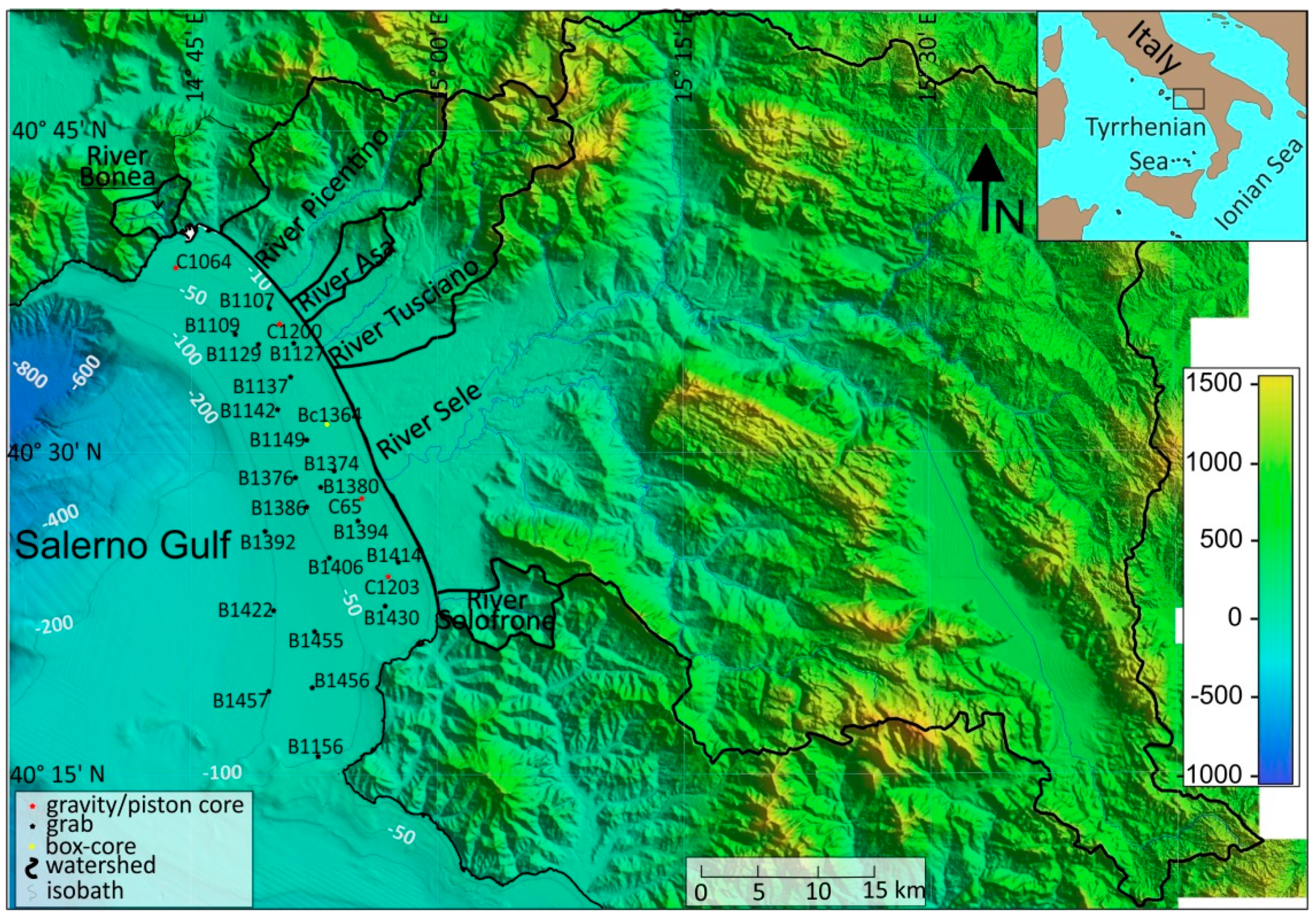
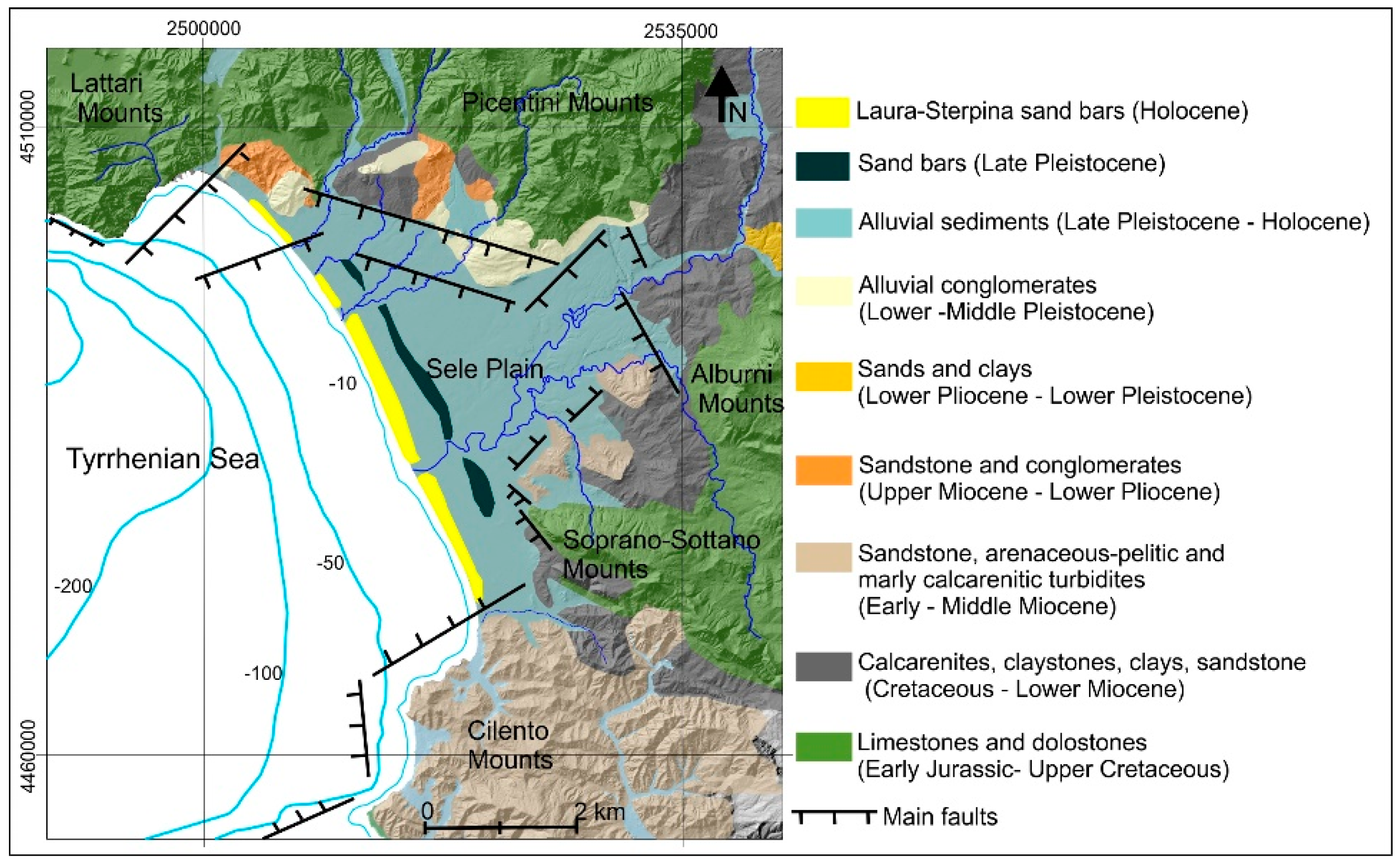
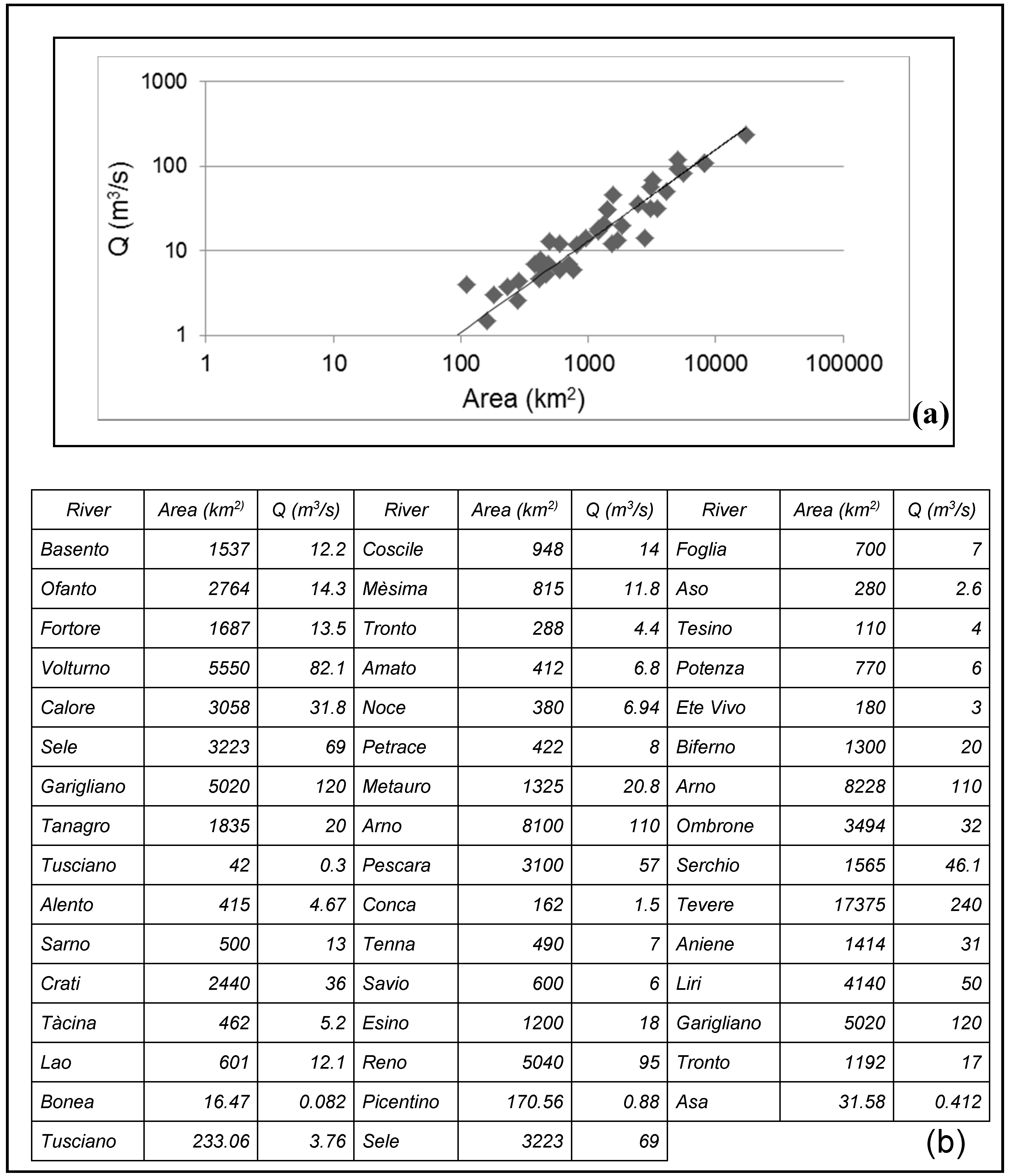
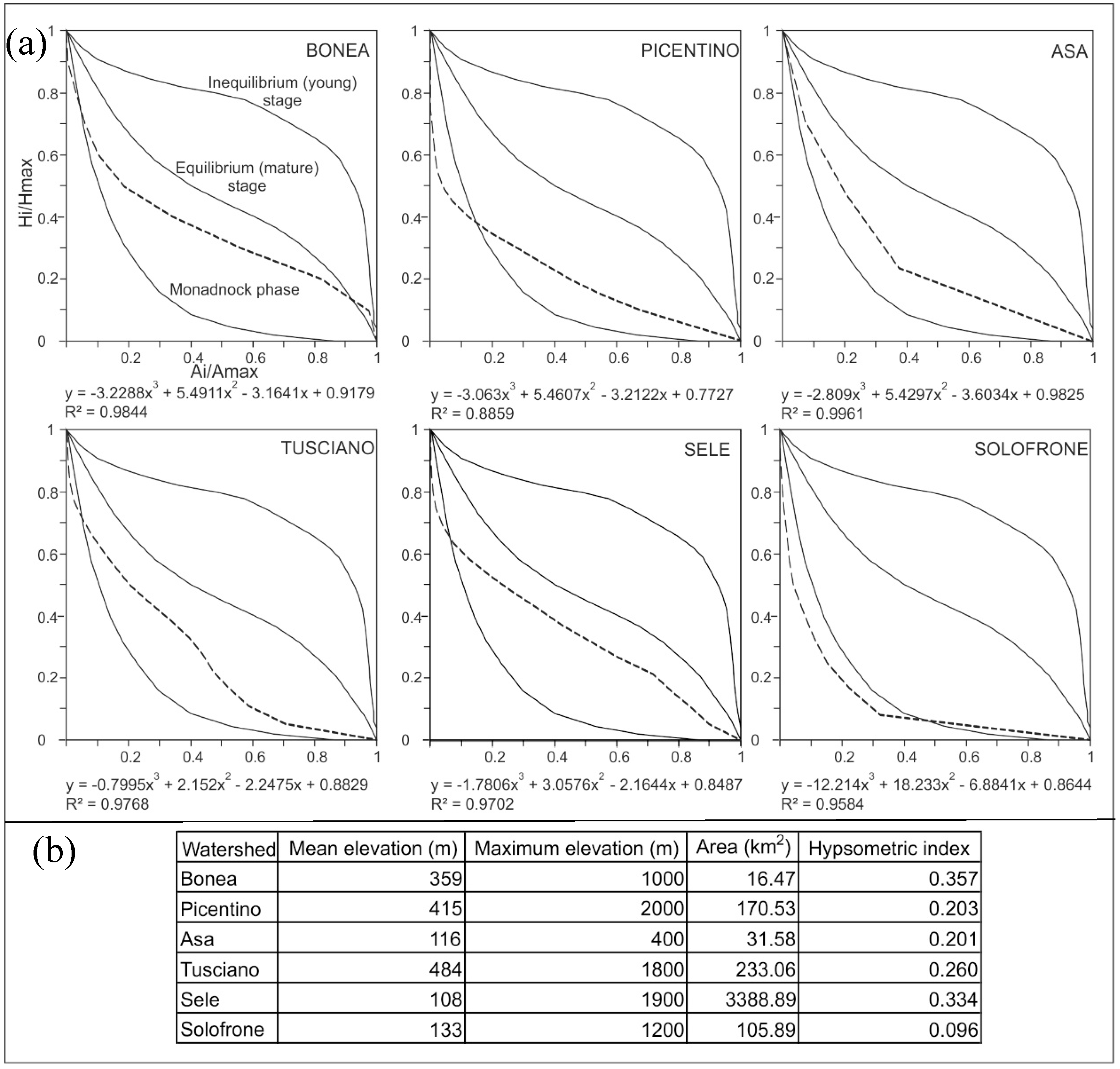

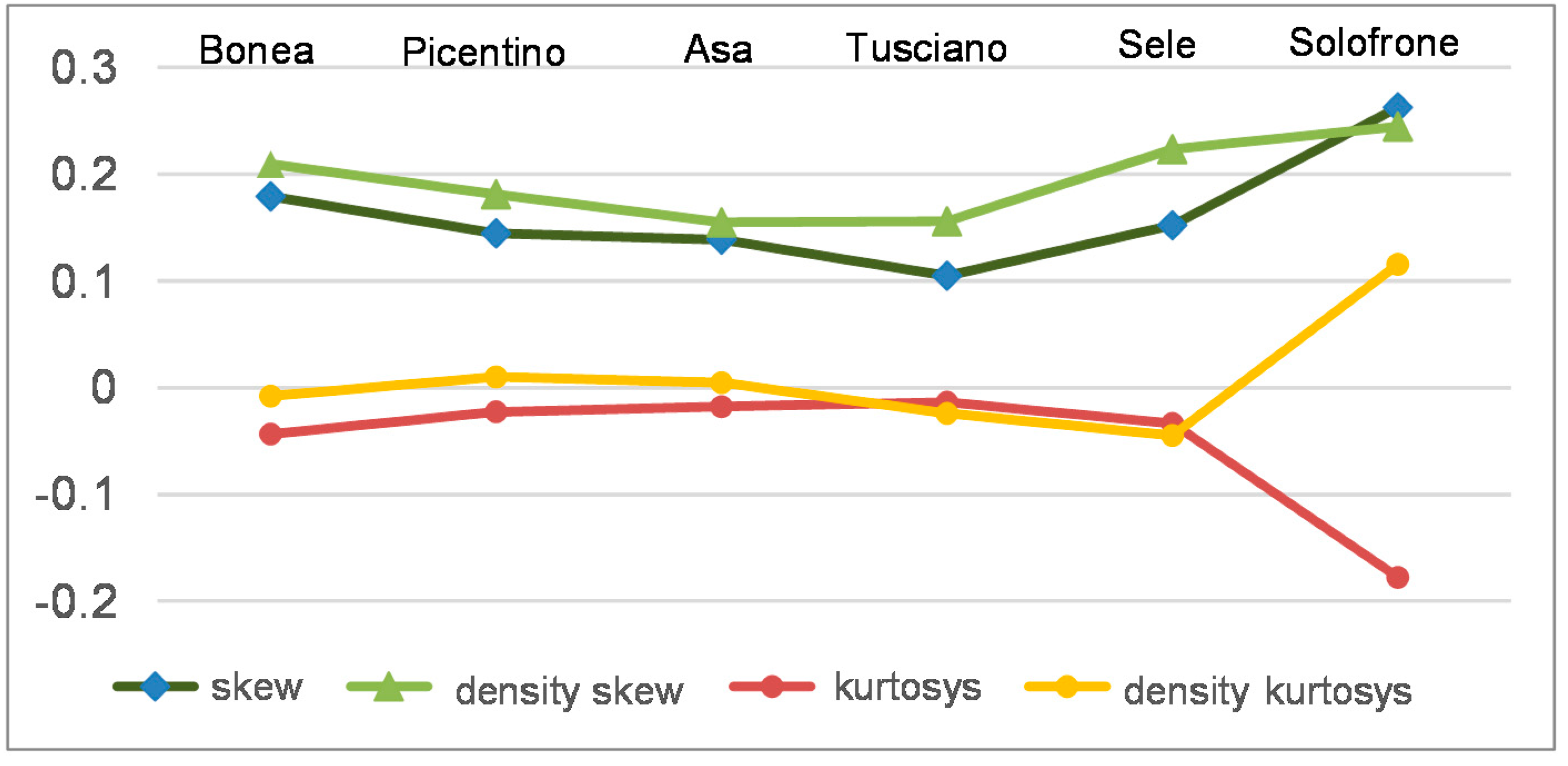

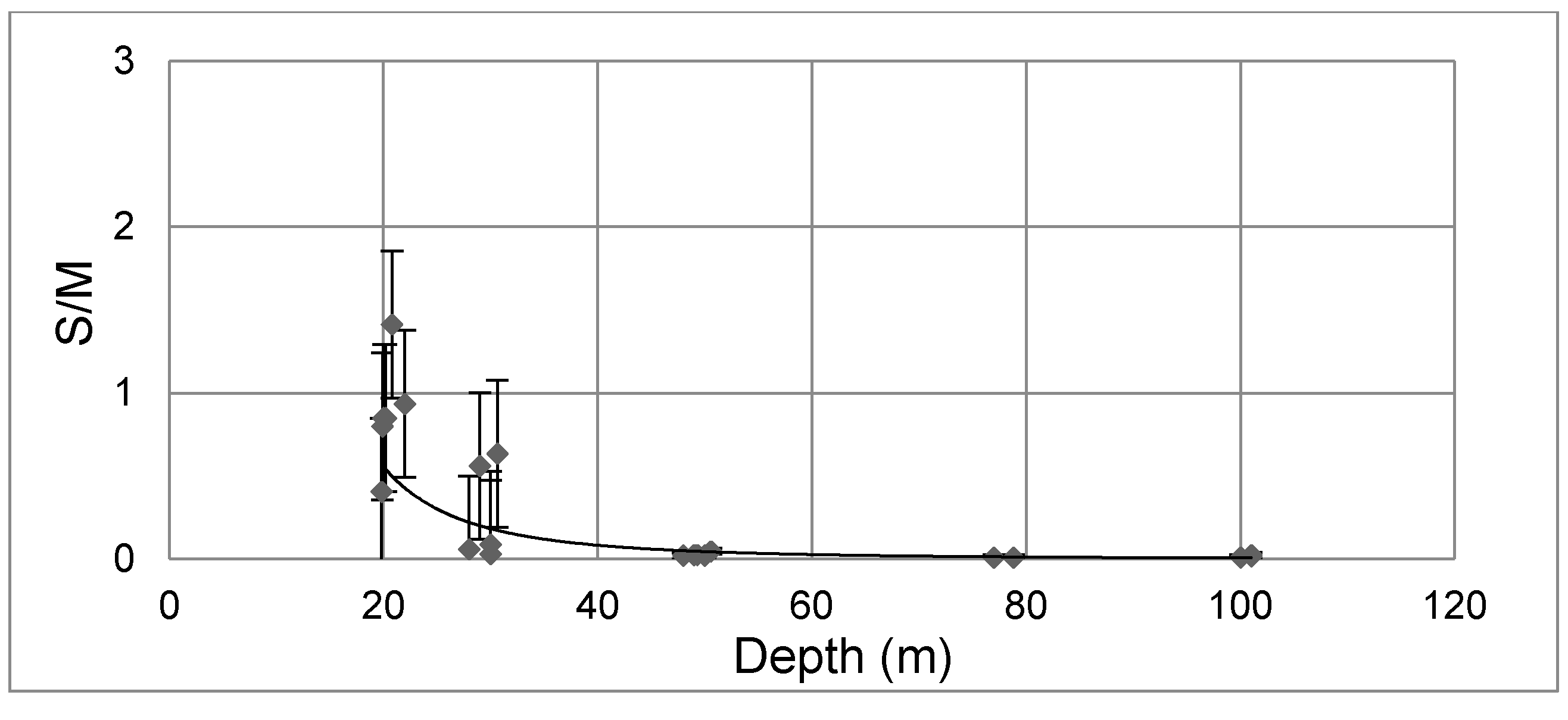
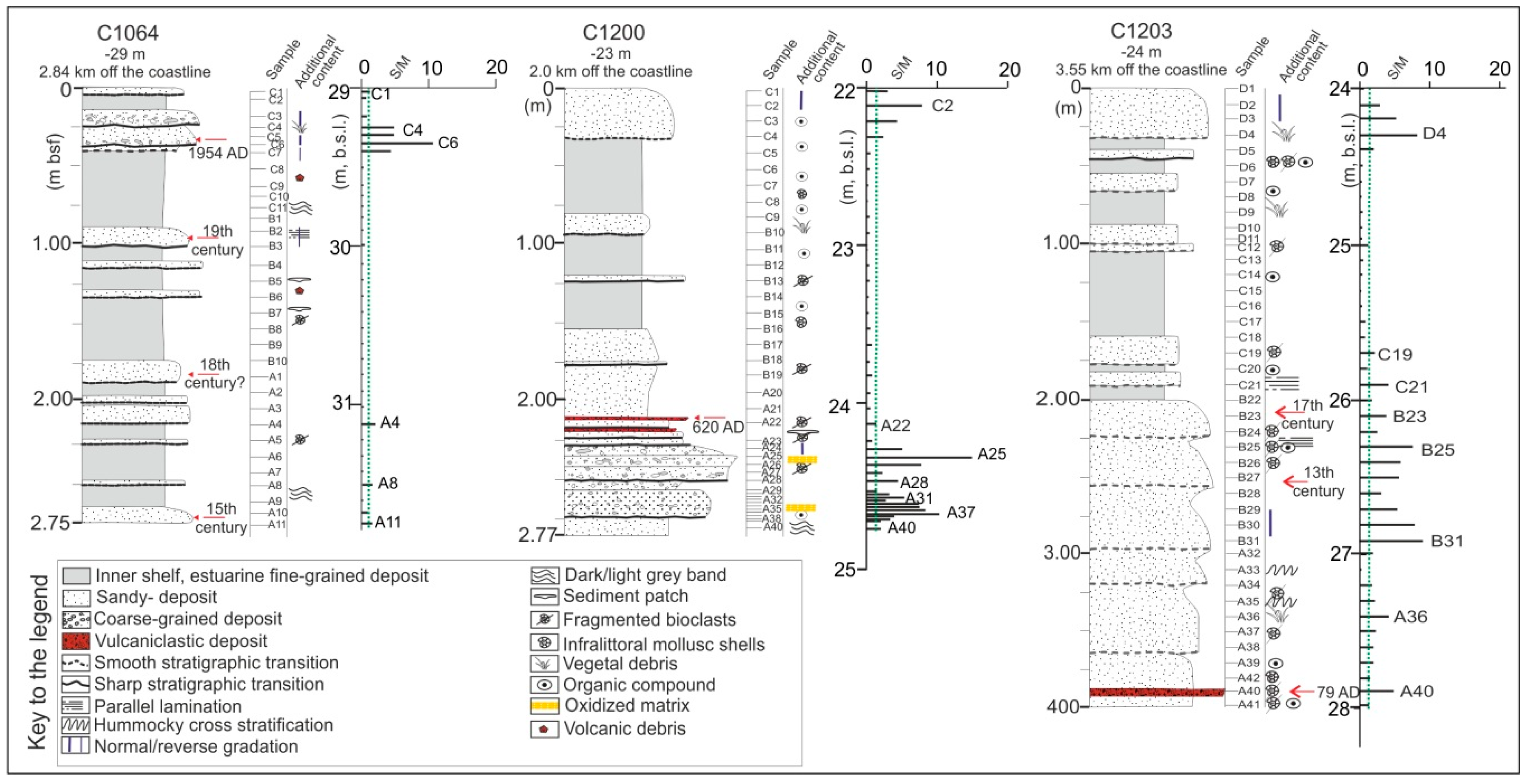
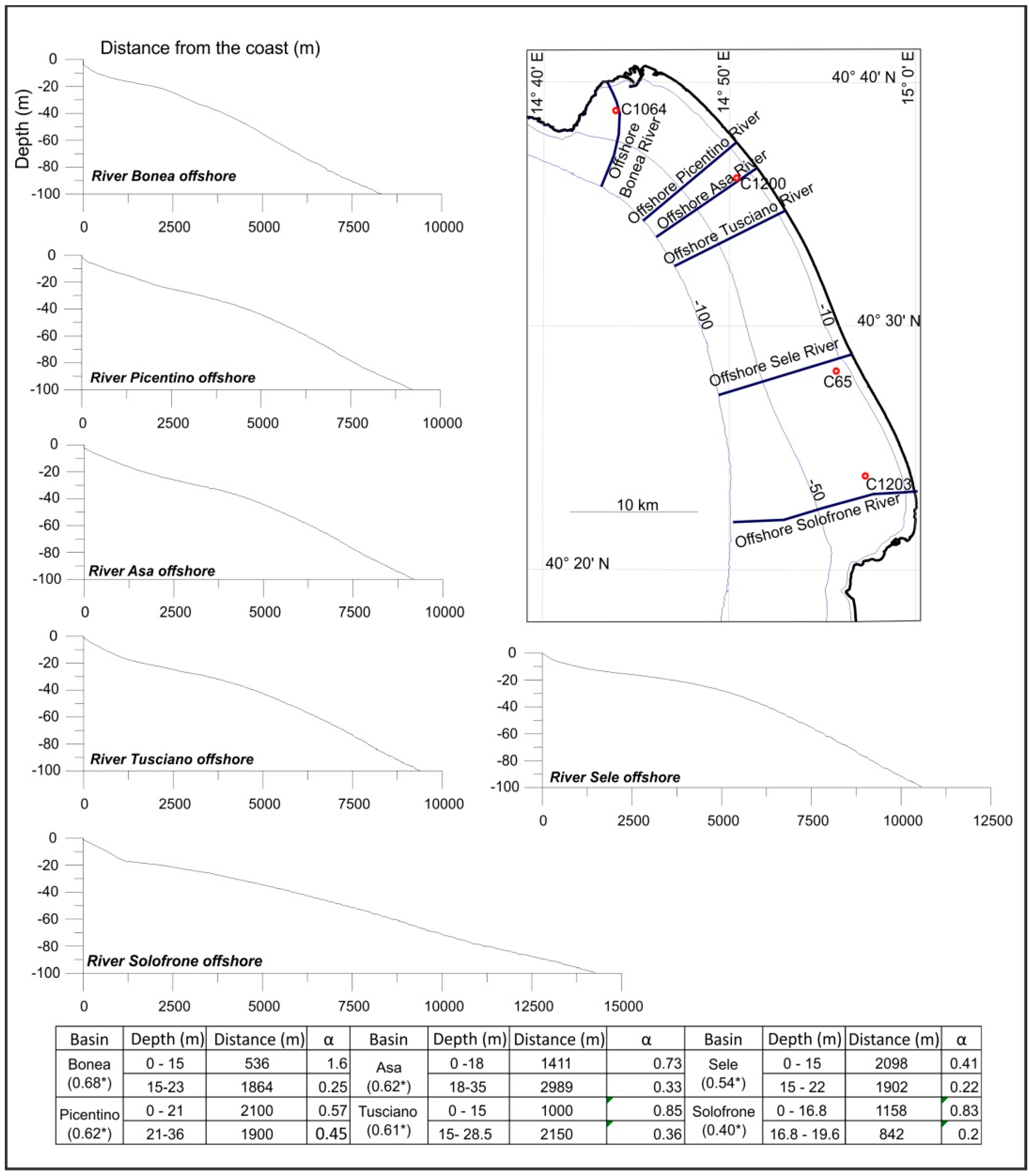
| River Watersheds | Qsav (kg/s) | Qav (m3/s) | Qflood (m3/s) | Csav (kg/m3) |
|---|---|---|---|---|
| Bonea | 8.32 | 0.08 | 12.49 | 101.44 |
| Picentino | 3.76 | 0.88 | 88.61 | 4.27 |
| Asa | 1.69 | 0.41 | 21.55 | 4.11 |
| Tusciano | 28.13 | 3.76 | 115.12 | 7.48 |
| Sele | 12.94 | 69.00 | 1086.06 | 0.19 |
| Solofrone | 1.03 | 1.30 | 59.48 | 0.79 |
© 2019 by the authors. Licensee MDPI, Basel, Switzerland. This article is an open access article distributed under the terms and conditions of the Creative Commons Attribution (CC BY) license (http://creativecommons.org/licenses/by/4.0/).
Share and Cite
Alberico, I.; Budillon, F. A Quantitative Evaluation of Hyperpycnal Flow Occurrence in a Temperate Coastal Zone: The Example of the Salerno Gulf (Southern Italy). Geosciences 2019, 9, 501. https://doi.org/10.3390/geosciences9120501
Alberico I, Budillon F. A Quantitative Evaluation of Hyperpycnal Flow Occurrence in a Temperate Coastal Zone: The Example of the Salerno Gulf (Southern Italy). Geosciences. 2019; 9(12):501. https://doi.org/10.3390/geosciences9120501
Chicago/Turabian StyleAlberico, Ines, and Francesca Budillon. 2019. "A Quantitative Evaluation of Hyperpycnal Flow Occurrence in a Temperate Coastal Zone: The Example of the Salerno Gulf (Southern Italy)" Geosciences 9, no. 12: 501. https://doi.org/10.3390/geosciences9120501
APA StyleAlberico, I., & Budillon, F. (2019). A Quantitative Evaluation of Hyperpycnal Flow Occurrence in a Temperate Coastal Zone: The Example of the Salerno Gulf (Southern Italy). Geosciences, 9(12), 501. https://doi.org/10.3390/geosciences9120501





